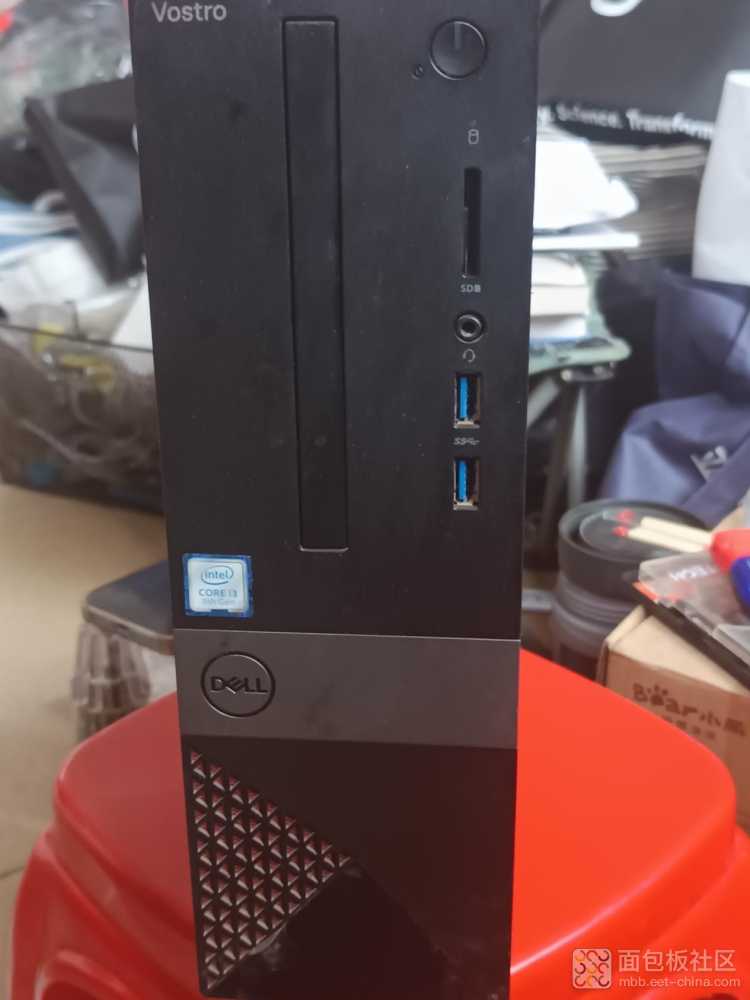
整机规格为293mm(深)× 92.6mm(宽) x290mm(高),整机容量7.8L。 前面板上方分布着按键和接口,包含了光驱接口、电源按钮、五合一介质卡读卡器插槽、组合音频插孔以及2个USB 3.0端口。 左侧的 INTEL 贴纸标明着这台主机采用了 Coffee Lake 架构的八代酷睿i3处理器。 前面板的中部则是Dell的银色横纹,配以刻入的 Dell 标志,最下方为菱格型设计的通风口,整体内凹,原理不明,但质感还是不错,红色的内纹理算是亮点。 Dell 的侧面同样是菱格型的通风口设计,其它部分就是金属板材了。 Dell 的背面,这个部分主要是I/O接口面板,可以看到接口的纵向分布还是较为均匀。 放大来看,由上之下分别是线路输入/输出端口/麦克风接口、VGA接口、HDMI端口、4个USB 2.0端口、千兆位以太网端口。 下方则是电源接口和电源指示灯。 要将背面同右侧面金属板的固定螺丝卸下,即可取下开箱。 开箱之后的状态如下图所示,整体看来着实非常紧凑。 电源规格方面为200W,电源功率:200–240V 交流电,50–60Hz。 可编程逻辑器件(CPLD/FPGA),用于集显的。 拆下查看之后,可以认出为镁光 8GB DDR4 2666MHz的内存条,中规中矩。 Dell 的硬盘被放置在银色的硬盘盒中,通过堆叠的方式节省了机箱内部空间。 Dell 所使用的硬盘是希捷的3.5英寸1TB机械硬盘,中规中矩,由于没有搭载额外的固态硬盘,所以这个机械硬盘也是系统所在。 Dell 的前面板也可以拆下,依靠两个卡扣,即可取下。 取下之后,可以看到光驱部分是一个铁皮,并没有配备光驱稍显可惜,毕竟光驱在商用领域还是比较关键的,展示下Dell 0的接口组件。 SATA 接口方面,除了已经使用的SATA0,还剩下SATA2、SATA3两个接口,但 Dell 仅有一个硬盘位,最大支持2TB(7200转)。 因为没有额外的机箱风扇,Dell 的 CPU 散热器还承担整机的散热。 Dell 预留了一个M.2接口,不出意外是 SATA 规格,支持扩展到512GB。 REALTEK 8111H 以太网收发器芯片。 NIKOS PKC1688 ,MOS场效电晶体,NIKO-SEM(尼克森)。 CPU 周围依然是有大量的NIKO-SEM(尼克森)的MOS场效电晶体。 NCP81220 电源管理芯片,来自ON的。 主板卡扣,电脑专用。 Winband 25Q256JVFQ华邦电子的闪存芯片。 左下角的SMSC SCH5553-NU(通信接口芯片)用于扩展主板功能的I/O芯片。 Dell 主要是面向商用,所以在硬件上尽可能的满足办公需求,虽然算不上中高端配置的,但在整机的搭配比较均衡,在一线品牌商用主机中的性价比上还是相当出色。 Dell 商用主机的亮点可以归结为:硬件满足需求且性价比十足,机箱体积轻巧不占工位,前置面板接口丰富,噪音小功耗低适合商务。



 标签: on
标签: on